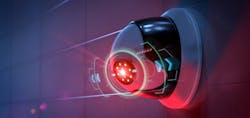Nearly all security cameras available today have some form of video analytics on board, according to Brian Baker, vice president, Americas, for Calipsa, a leading provider of deep learning-powered video analytics for false alarm reduction. But why is this the case? And what do facilities managers need to know about it?
Video analytics powered by artificial intelligence promise smarter alerts that free your security staff from responding to false alarms, says Baker, a presenter at the 2020 GSX+ virtual tradeshow. But to find the right AI-backed analytics for your organization, it’s first important to understand the basic concepts behind the technologies.
What Are Artificial Intelligence and Machine Learning?
Artificial intelligence includes “any technique that enables a computer to mimic human intelligence,” Baker explains. Some of these techniques include the if-then rules that older analytics technologies rely on. For example, a camera notices something is moving. If motion is detected, then the camera determines whether the moving object is shaped like a car. The camera may then issue you an alert based on the answer.
Machine learning is one type of artificial intelligence that uses statistics to find patterns in vast amounts of data, then applies the patterns to make predictions. Machine learning allows devices to improve at tasks as they gain experience. Streaming media services, for example, rely on machine learning to recommend new shows and music for users, Baker explains.
“If you watch Breaking Bad on Netflix, you’re telling the algorithm to look for similar shows to recommend,” Baker says. “While looking at the viewing patterns of people who watch Breaking Bad, the algorithm will also draw on information such as the genre, the presenter and the year it was made to suggest new shows for you to watch.”
Deep learning is a subset of machine learning where the algorithm trains itself to perform tasks by exposing deep neural networks to vast amounts of data. Deep neural networks mimic the way neurons work in the brain, in that they’re made of many layers of nodes that are each responsible for solving part of an overall task. The nodes work together to process complex information, find patterns and make decisions.
Why is Machine Learning Important for Video Analytics?
Security is traditionally very dependent on people power, even when video is involved, Baker explains. Guards and control room operators have to monitor multiple continuous streams of video and spend time reviewing (often constant) alerts from security cameras. Machine learning lets technology take care of some of the basic work, which allows guards and control room operators to use their time more efficiently, Baker explains.
“Around 95% of the alarms from security cameras are nuisance alarms that don’t contain any activity,” Baker says. “Nuisance alarms can be triggered by things like a change in lighting, trees moving in the breeze, or cobwebs or spiders on the camera.”
Security staffers still have to review all of those nuisance alarms in case they’re legitimate, eating up a lot of time that could be spent responding to real alarms.
Artificial intelligence that’s been trained to look for human activity is a powerful tool for reducing the frequency of nuisance alarms, which then allows human operators to respond to real security threats faster and more efficiently, Baker says.
Applications for Facilities
Machine learning is transforming the security camera landscape at a rapid pace. Products currently on the market can do things like analyze stationary situations, such as how long a vehicle has been parked in a particular area.
Today’s cameras continue to learn after they arrive at your facility – for example, learning to recognize people who are pushing shopping carts, which could be useful in a retail environment. You can even set up alerts based on how many people have entered a certain area or building.
Although the market is seemingly changing at the speed of light, it’s important for facilities managers to know the basics and become more informed consumers. Understanding the foundations of AI and machine learning will empower you to compare cameras and video analytics packages on a deeper level. New video analytics strategies for security are changing the physical security landscape – and you can use these new capabilities to keep your building safer.
Read more content from GSX+ 2020:
About the Author
Janelle Penny
Editor-in-Chief at BUILDINGS
Janelle Penny has been with BUILDINGS since 2010. She is a two-time FOLIO: Eddie award winner who aims to deliver practical, actionable content for building owners and facilities professionals.

